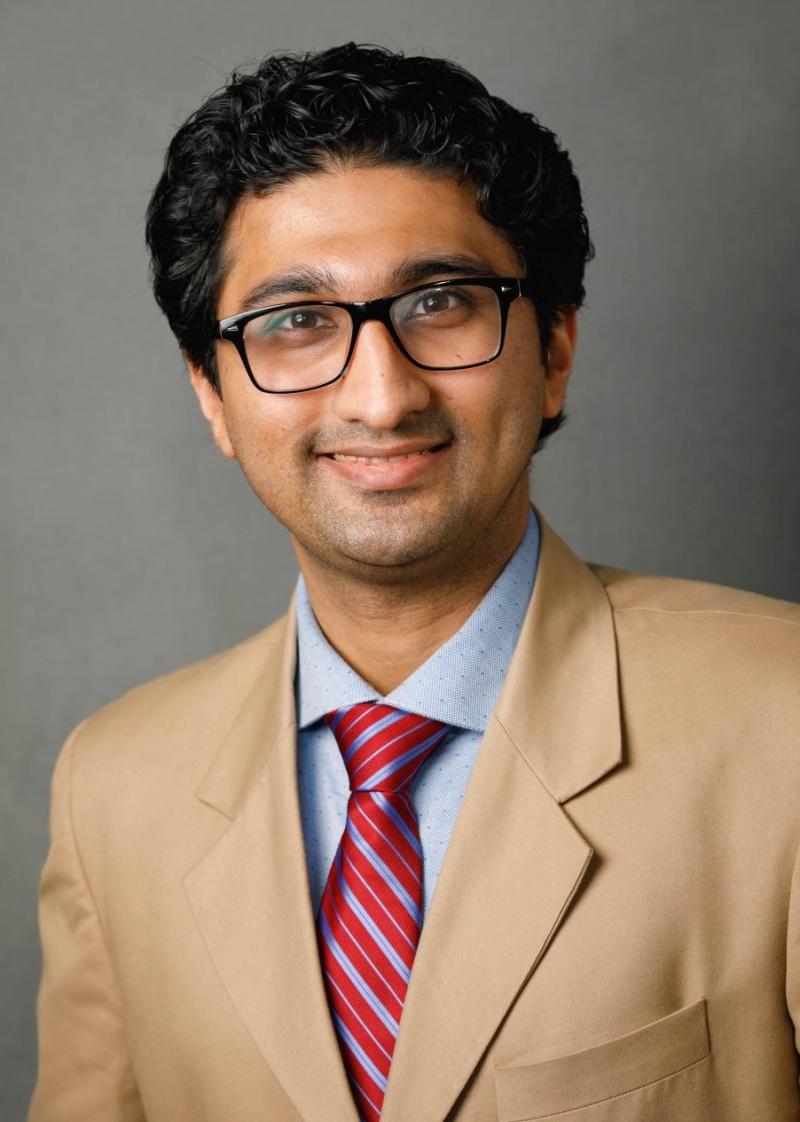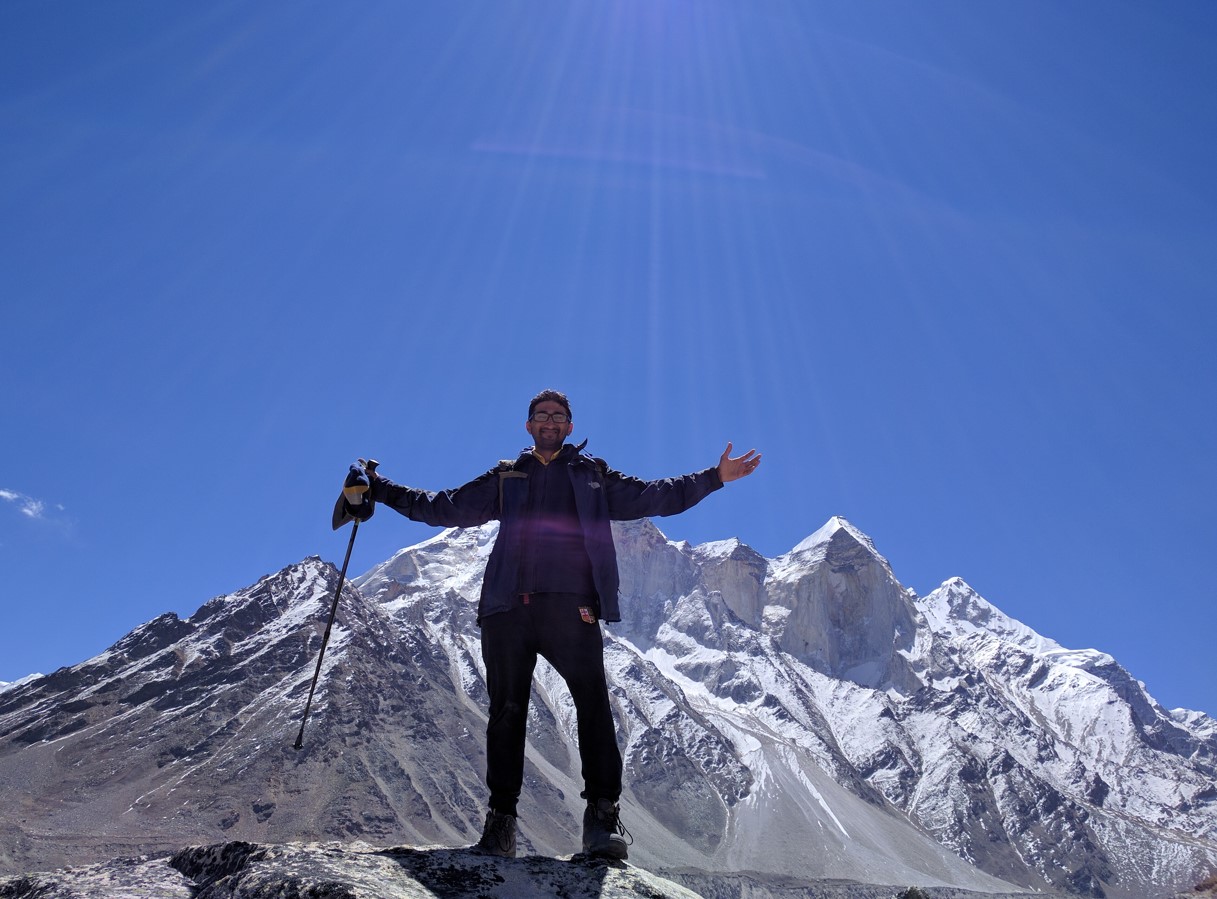
Yash Shah, MD, knew his life’s calling as a young doctor, after seeing the resilience and faith of the mother of a five-year old boy with cerebral palsy and intractable epilepsy. He started a master’s degree in epidemiology in addition to his neurology residency so he could conduct research while also treating children with epilepsy. Now Shah is completing his training at the Duke Neurology Clinical Neurophysiology Fellowship Program.
In this week’s Spotlight interview Shah talks to us about his life as a fellow, his hopes for managing complex epilepsy cases while training residents and fellows, and his loves of hiking, singing and playing the harmonium when he’s not at work.
What are your current responsibilities as a clinical neurophysiology fellow? What does a typical day look like for you?
As a clinical neurophysiology fellow, I am responsible for interpreting inpatient EEGs of all kinds including stereotactic EEGs, intraoperative monitoring, evoked potentials and surgical planning for complex epilepsy cases, and refractory to medical therapy.
I enjoy starting my day by 5 am with sipping a hot cup of coffee while reviewing EEGs from the previous night in our EEG reading room. This is then followed by an active discussion with my attending on call, to review my findings.
Later during the day, we round on patients in the Epilepsy Monitoring Unit (EMU). The location varies, depending upon the rotation (eg. Pediatric, Adult or Durham VA hospital). We then have dedicated lectures in either Clinical Neurophysiology or Epilepsy. In the afternoon, besides reading prolonged/routine EEGs and STAT requests, I see patients at the epilepsy clinic twice a week.
On other days, I am in the Operating Room (OR) confirming placement and functioning of implanted electrodes in patients undergoing intracranial electrocorticography (ECOG). With the rest of my time, I either work on research or learn newer technological tools involved in brain mapping and epilepsy surgery planning (eg. BRAINLAB, CURRY etc). When I am working nights, my day begins at 5 PM, and it involves interpreting prolonged EEGs and ambulatory EEGs.
How and when did you get interested in pediatric neurology? How did you decide to focus on clinical neurophysiology and epilepsy?
In the management of seizures, while many patients’ lives are positively impacted with seizure control, others reside in the shadow and fail to achieve adequate control. I encountered the latter scenario when I took care of a 5-year-old Indian boy with cerebral palsy, who suffered from intractable epilepsy. His mother, however, remained optimistic and had complete trust in us that we would somehow find a way to control his seizures. This triggered my longing to help children with similar conditions, which served as a driving force for me to pursue training in pediatric neurology and epilepsy.
I obtained a masters in epidemiology and statistics to be engaged in epilepsy research in parallel. The outcome of one of my research studies contributed to the monitoring of Felbamate with blood counts and liver function tests as a standard of care (PMID- 26828692). Another study aided in establishing the efficacy of Perampanel for treating various types of adult and pediatric epilepsy syndromes (PMID-27300147).
My love for epilepsy grew stronger when I did a month of EEG elective. I absolutely enjoyed the process of viewing and interpreting video EEGs. I have always been intrigued by how merely looking at different wave patterns, we can determine a patient’s level of consciousness, nature of physical activity, emotional state and type of seizures.
My neurology residency training allowed me to build a solid foundation in epilepsy and research. I have reviewed electroencephalograms of hundreds of patients and have discussed many of them during our weekly conferences, including rare and complicated epilepsy patients such as epilepsy surgery candidates. Epilepsy covers a broad spectrum of disorders, and so each case unique, which makes this field challenging as well as interesting.
What was your experience like as a chief resident during the COVID-19 outbreak? What’s one helpful strategy or thing you’ve learned from surviving 2020?
COVID 19 was certainly a challenging time for most of us. Fortunately, we quickly discovered that much of the work can be done remotely, such as seeing patients with less medical complexity through telemedicine and reading EEGs from home. As a chief resident, I was able to organize several grand round sessions with international experts in pediatric neurology and clinical neurophysiology as guest speakers.
We were also able to structure and conduct online education curriculum for residents. The most helpful strategy for remote work during COVID-19 season was to get a standing desk with a faster computer with two big dual screen monitors (a must for EEGers!) and of-course a super fast Internet connection!
What plans do you have for after you complete your fellowship? If you could have any job in the world, what would it be?
The area of clinical neurophysiology and epilepsy that excites me the most is to learn and get involved in managing complex epilepsy surgery cases and actively participating in teaching residents and fellows. Thus an ideal work environment would be one that gives me an opportunity to fulfill both these objectives.
In addition to your medical degree, you have an MPH in Epidemiology and Biostatistics. What interests you the most about those fields?
The practical advantage is that you can read and interpret medical literature including complex randomized control trials, meta-analysis and systematic reviews and critically appraise the material before applying that knowledge in practice. Another advantage is that it helps you design and conduct clinical trials.
How does your knowledge and experience in epidemiology and biostatistics influence your work as a pediatric neurologist?
Pediatric neurology and epilepsy is a growing field. There are several diseases that are either difficult to diagnose, or currently lack treatment options. The experience gained from my statistics and epidemiology has helped me in conducting some successful research studies (Yash D. Shah - Google Scholar).
What other passions or hobbies do you have outside of work?
I play harmonium (an Indian classical instrument) and like singing Indian classical music. I enjoy hiking with my wife Prathipa, who is a pediatric GI fellow at UNC. We love dogs and are excited about adopting one next year!

Shah poses at the end of a difficult seven-day expeditions of Tapovan and Gangotri (a glacier which gives rise to the holy river the Ganges) in 2016 with his hiker parents, perched at an elevation of 4463 meters about 14,640 feet above sea level in the Himalayas.